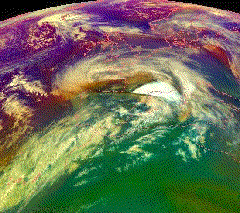|
Hurricane Daniel
The name Daniel has been used for ten weather systems worldwide: eight tropical cyclones in the eastern Pacific Ocean and two European windstorms (with one later becoming a Mediterranean tropical-like cyclone). In the Eastern Pacific: * Hurricane Daniel (1978), a Category 3 hurricane that did not affect land. * Hurricane Daniel (1982), a Category 3 which reached Hawaii as a tropical depression and dissipated in the Alenuihaha Channel between Maui and the Big Island. * Tropical Storm Daniel (1988), did not make landfall. * Tropical Storm Daniel (1994), no reports of damage or casualties * Hurricane Daniel (2000), a Category 3 hurricane that threatened Hawaii for a time while weakening. * Hurricane Daniel (2006), a powerful Category 4 hurricane that brought rain to Hawaii as a tropical depression. * Hurricane Daniel (2012), a Category 3 hurricane that did not affect land. * Tropical Storm Daniel (2018), a weak tropical storm that never threatened land. In Europe: * Storm Danie ... [...More Info...] [...Related Items...] OR: [Wikipedia] [Google] [Baidu] |
Weather System
In meteorology, a low-pressure area, low area or low is a region where the atmospheric pressure is lower than that of surrounding locations. Low-pressure areas are commonly associated with inclement weather (such as cloudy, windy, with possible rain or storms), while high-pressure areas are associated with lighter winds and clear skies. Winds circle anti-clockwise around lows in the northern hemisphere, and clockwise in the southern hemisphere, due to opposing Coriolis forces. Low-pressure systems form under areas of wind divergence that occur in the upper levels of the atmosphere (aloft). The formation process of a low-pressure area is known as cyclogenesis. In meteorology, atmospheric divergence aloft occurs in two kinds of places: * The first is in the area on the east side of upper troughs, which form half of a Rossby wave within the Westerlies (a trough with large wavelength that extends through the troposphere). * A second is an area where wind divergence aloft occurs a ... [...More Info...] [...Related Items...] OR: [Wikipedia] [Google] [Baidu] |
European Windstorm
European windstorms are powerful extratropical cyclones which form as cyclonic windstorms associated with areas of low atmospheric pressure. They can occur throughout the year, but are most frequent between October and March, with peak intensity in the winter months. Deep areas of low pressure are common over the North Atlantic, and occasionally start as nor'easters off the New England coast. They frequently track across the North Atlantic Ocean towards the north of Scotland and into the Norwegian Sea, which generally minimizes the impact to inland areas; however, if the track is further south, it may cause adverse weather conditions across Central Europe, Northern Europe and especially Western Europe. The countries most commonly affected include the United Kingdom, Ireland, the Netherlands, Norway, Germany, the Faroe Islands and Iceland. The strong wind phenomena intrinsic to European windstorms, that give rise to "damage footprints" at the surface, can be placed into three cat ... [...More Info...] [...Related Items...] OR: [Wikipedia] [Google] [Baidu] |
Mediterranean Tropical-like Cyclone
Mediterranean tropical-like cyclones, often referred to as medicanes (a portmanteau of Mediterranean hurricanes) but sometimes also as Mediterranean cyclones or as Mediterranean hurricanes, are meteorological phenomena occasionally observed over the Mediterranean Sea. On a few rare occasions, some storms have been observed reaching the strength of a Category 1 hurricane, on the Saffir–Simpson scale, and one storm has been recorded reaching Category 2 intensity. The main societal hazard posed by medicanes is not usually from destructive winds, but through life-threatening torrential rains and flash floods. The occurrence of medicanes has been described as not particularly rare. Tropical-like systems were first identified in the Mediterranean basin in the 1980s, when widespread satellite coverage showing tropical-looking low pressures which formed a cyclonic eye in the center were identified. Due to the dry nature of the Mediterranean region, the formation of tropical, subtropi ... [...More Info...] [...Related Items...] OR: [Wikipedia] [Google] [Baidu] |
Hurricane Daniel (1978)
The 1978 Pacific hurricane season was the first Pacific hurricane season to use both masculine and feminine names for tropical cyclones. It also began the modern practice of utilizing naming lists every six years. Despite lacking an El Niño, a common driver of enhanced activity in the East and Central Pacific basins, the 1978 season was active. It featured 19 named storms, 14 hurricanes, and 7 major hurricanes, the latter of which are Category 3 or stronger cyclones on the Saffir–Simpson scale. Within the confines of the Central Pacific basin, located between the International Date Line and 140°W, 13 tropical cyclones or their remnants were observed by forecasters at the Central Pacific Hurricane Center, a record number of occurrences at the time. Seasonal activity began on May 30 and ended on October 21, within the limits of a traditional hurricane season which begins on May 15 in the East Pacific and June 1 in the Central Pacific. The season ends on No ... [...More Info...] [...Related Items...] OR: [Wikipedia] [Google] [Baidu] |


